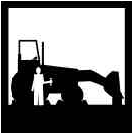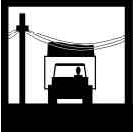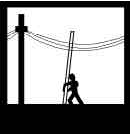Almost
all agricultural operations involve implements of some kind.
Safe use of these implements is of prime importance. Most
injuries can be prevented simply by paying attention to the
job at hand. Trouble comes from taking shortcuts because you
are in a hurry or too impatient to do the job correctly. Slowing
down and taking a few seconds more to do the job correctly
and safely is more important and less costly than having to
do the job over again or being injured in the process.
|
|
|
| . Failure to turn off the tractor and implement's power and to wait for the machine to stop moving completely before repairing or adjusting the machine. You risk the possibility of getting hands or clothing caught in or on the PTO or in a moving pulley, belt, or chain while attempting to work on a machine while it is running. Likewise, bystanders or others working on the machine can get entangled in it. | 
|
| .
Failing to block raised implements when working on them. . Riders on the implement. Riders can be thrown from or slip off. They can be either run over by the implement or fall into it. . Not paying attention when working with the machine. Operators need to react to changing conditions as the implement does its work. . Exposed moving parts (pulleys, PTO's, cutter bars, shafts, belts, chains, etc.). |

|
|
|
|
| 1. Keep all safety shields in place and in good repair. Rotating shafts cause severe injury in a matter of seconds by entangling loose or dangling clothing. Certain types of farm machinery cannot be completely guarded due to the nature of their work. Keep a safe distance from all cutting or moving parts. Mowing equipment will cut people as well as hay or weeds. Do not allow anyone to lean, push, or stand on diggers to aid in penetration. | |
| 2. Implements are not a safe place for riders. Do not allow riders on implements for any reason unless that implement is designed specifically for a person to ride and perform an operation on that implement. Riders could slip off and fall under the implement resulting in serious injury or death. Likewise, tractor riders can fall off and be run over by the implement before the operator can stop. | |
| 3. When repairing or working on an implement, make sure it is lowered to the ground. It should be braced or blocked securely if you have to work on it in the raised position, don't depend on hydraulic cylinders to support the implement alone. When making repairs on a slope, block the wheels. | |
| 4. Always turn off power source and wait for all moving parts to stop before working on the implement. Take the key with you before working on the machine to prevent others from starting the machine while you are working on it. Select proper speeds for harvesting that will prevent clogging thus reducing the need to unclog the implement. | |
| 5. Make sure the operator knows how to operate the machine. The operator needs to know how the machine will respond in any given situation. The operator's manual is a good source of information and should be reviewed thoroughly. If the implement. requires wider turns, the operator needs to slow down on turns and avoid tight places. | |
| 6. Wear proper clothing when working on implements. Loose fit clothing can get caught in rotating shafts and PTOs and cause serious injury. Make sure all moving parts are stopped and turned off before approaching. Keep a safe distance away from all moving parts. | 
|
| 7. Cutting equipment is very hazardous. Keep a safe distance from all cutting implements. | |
| 8. Make sure all equipment is in good working order. All pins should be in place, all bolts and screws should be tight, and all other parts should be secure and properly adjusted. | |
| 9. Know how high and wide your equipment is. Look up when moving equipment in the yard. Know where power lines are and avoid them. Be aware, also, of buildings, fences, and other obstacles when moving equipment through yards. When turning in fields slow down and allow room to clear obstacles. | 

|
| 10. When parking equipment, block the wheels so that the machine will not roll. Hydraulically raised equipment should be lowered and should have the transport lock engaged when parked or blocked. If this is not possible or the equipment needs to be raised, then block the equipment with jack stands or other suitable means. | |
| 11. Match the proper tractor for the implement. The tractor should be properly weighted and able to control the implement, especially when going up or down inclines. | |

|
|
|
| .
Turn power off the tractor or implement before making
repairs. . No riders on implements. . Work smart by being thorough and not hurried. . Block raised implements before making repairs. . Be cautious around moving parts. . Make sure equipment is in good working order. |
Written
by Tom Karsky, University of Idaho, and A. K. Jaussi, former
graduate assistant, Washington State University. For more
information about farm safety, please contact:
| Published December 1998 | Harvesting Hay and Forages | Farm Safety Series PNW 512 |
Disclaimer and Reproduction Information: Information in NASD does not represent NIOSH policy. Information included in NASD appears by permission of the author and/or copyright holder. More